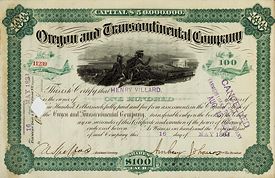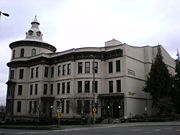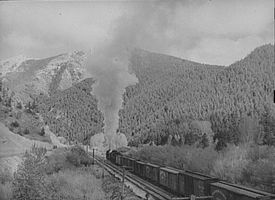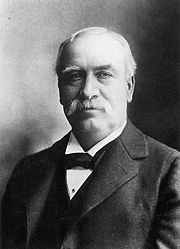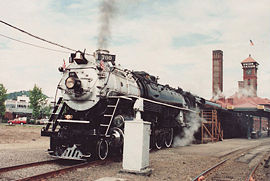Northern Pacific Railway
2008/9 Schools Wikipedia Selection. Related subjects: Railway transport
| Northern Pacific Railway | |
|---|---|
| Reporting marks | NP |
| Locale | Ashland, Wisconsin and St. Paul, Minnesota to Seattle, Washington, Tacoma, Washington and Portland, Oregon |
| Dates of operation | 1864–1970 |
| Successor line | Burlington Northern |
| Track gauge | 4 ft 8½ in (1,435 mm) ( standard gauge) |
| Headquarters | Saint Paul, Minnesota |
The Northern Pacific Railway ( AAR reporting marks NP) was a railway that operated in the north-central region of the United States. The railroad served a large area, including extensive trackage in the states of Idaho, Minnesota, Montana, North Dakota, Oregon, Washington and Wisconsin. The company was headquartered first in Brainerd, Minnesota, then in St. Paul, Minnesota.
History
Organization and first rail
The Northern Pacific was chartered on July 2, 1864 as the first northern transcontinental railroad in the United States. It was granted some 47,000,000 acres (190,000 km²) of land in exchange for building rail transportation to an undeveloped territory. Josiah Perham (for whom Perham, Minnesota, is named) was elected its first president on December 7, 1864.
Jay Cooke appears
For the next six years, backers of the road struggled to find financing. Though John Gregory Smith succeeded Perham as president on January 5, 1866, groundbreaking did not take place until February 15, 1870, at Thompson Junction, Minnesota, 25 miles (40 km) west of Duluth, Minnesota. The backing and promotions of famed Civil War financier Jay Cooke in the summer of 1870 brought the first real momentum to the company.
Over the course of 1870, the Northern Pacific pushed westward from Minnesota into present-day North Dakota. It also began reaching from Kalama, Washington Territory, on the Columbia River outside of Portland, Oregon, towards Puget Sound. Four small construction engines were purchased, the Minnetonka, Itaska, Ottertail and St. Cloud, the first of which was shipped to Kalama by ship around Cape Horn. In Minnesota, the Lake Superior and Mississippi Railroad completed construction of its 155 mile (250 km) line stretching from St. Paul, Minnesota, to Lake Superior at Duluth in 1870. It was leased to the Northern Pacific the following year, and was eventually absorbed by the Northern Pacific.
In 1871, Northern Pacific completed some 230 miles (370 km) of railroad on the east end of its system, reaching out to Moorhead, Minnesota, on the North Dakota border. In the west, the track extended 25 miles north from Kalama. Surveys were carried out in North Dakota protected by 600 troops from General Winfield Scott Hancock. Headquarters and shops were established in Brainerd, Minnesota, a town named for the President John Gregory Smith's wife Anna Elizabeth Brainerd.
In 1872, the company put down 164 miles (264 km) of main line across North Dakota, with an additional 45 miles (72 km) in Washington. On November 1, General George Washington Cass became the third president of the company. Cass had been a vice-president and director of the Pennsylvania Railroad, and would lead the Northern Pacific through some of its most difficult times.
Attacks on survey parties and construction crews building into Native American homelands in North Dakota became so prevalent the company appealed for Army protection from President Ulysses S. Grant.
In 1872 the Northern Pacific also opened colonization offices in Europe, seeking to attract settlers to the sparsely populated and undeveloped region it served. Survey parties accompanied by Federal troops, railroad construction, permanent settlement and development, along with the discovery of gold in nearby South Dakota, all served as a backdrop leading up to the Battle of the Little Bighorn and the defeat of General George Armstrong Custer in 1876.
Panic of 1873 and first bankruptcy
In 1873, Northern Pacific made impressive strides before a terrible stumble. Rails from the east reached the Missouri River on June 4. After several years of study, Tacoma, Washington, was selected as the road's western terminus on July 14. However, for the past three years the financial house of Jay Cooke and Company had been throwing money into the construction of the Northern Pacific. Like many western transcontinentals, the staggering costs of building a railroad into a vast wilderness were drastically underestimated.
For a variety of reasons, led by the costs of constructing the railroad itself, Cooke and Company closed its doors on September 18. Soon, the Panic of 1873 engulfed the United States, ushering in a severe recession which would drag on for several years.
The Northern Pacific, however, survived bankruptcy that year, due to austerity measures put in place by President Cass. In fact, working with last-minute loans from Director John C. Ainsworth of Portland, the Northern Pacific completed the line from Kalama to Tacoma, 110 miles (177 km), before the end of the year. On December 16, the first steam train arrived in Tacoma. The year of 1874, however, found the company moribund.
Northern Pacific slipped into its first bankruptcy on June 30, 1875. Cass resigned to become receiver of the company, and Charles Barstow Wright became fourth president of the company. Frederick Billings, namesake of Billings, Montana, formulated a reorganization plan which was put into effect. This same year George Custer was assigned to Fort Rice, Dakota Territory, and charged with protecting the railroad survey and construction crews.
Frederick Billings and first reorganization
In 1877, construction resumed in a small way. Northern Pacific pushed a branch line southeast from Tacoma to Puyallup, Washington and on to the coal fields around Wilkeson, Washington. Much of the coal was destined for export through Tacoma to San Francisco, California, where it would be thrown into the fireboxes of Central Pacific Railroad steam engines.
This small amount of construction was one of the largest projects the company would undertake in the years between 1874 and 1880. That same year the company built a large shop complex at South Tacoma, Washington. For many years the shops at Brainerd and South Tacoma would carry out heavy repairs and build equipment for the railroad.
On May 24, 1879, Vermont lawyer Frederick Billings became the president of the company. Billings' tenure would be short but ferocious. Reorganization, bond sales, and improvement in the U.S. economy allowed Northern Pacific to strike out across the Missouri River by letting a contract to build 100 miles (160 km) of railroad west of the river. The railroad's new-found strength, however, would be seen as a threat in certain quarters.
Henry Villard, Gold Creek, Gold Spike
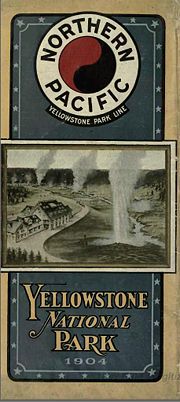
Ferdinand Heinrich Gustav Hilgard had been born in Bavaria in 1835, emigrating to America in 1853, at the age of 18. Settling in Illinois, the well-educated Hilgard became a journalist and editor, covering the Lincoln-Douglas debates, then the American Civil War for the larger New York papers, changing his name to Henry Villard along the way. He went back to his native Germany in 1871, where he came in contact with European financial interests speculating in American railroads.
When he returned to the United States after the Panic of 1873, he was the representative of these concerns. In the few short years prior to 1880, Villard intervened on the behalf of these interests in several transportation systems in Oregon. Through Villard's work, most of these lines wound up in the hands of the European creditors' holding company, the Oregon and Transcontinental Company.
Of the lines held by the Oregon and Transcontinental, the most important was the Oregon Railway and Navigation Company, a line running east from Portland along the south bank of the Columbia River to a connection with the Union Pacific Railroad's Oregon Short Line at the confluence of the Columbia River and the Snake River near Wallula, Washington.
Within a decade of his return, Henry Villard became the head of a transportation empire in the Pacific Northwest that had but one real competitor, the ever-expanding Northern Pacific. Northern Pacific's completion threatened the holdings of Villard in the Northwest, and especially in Portland. Portland would become a second-class city if the Puget Sound ports at Tacoma and Seattle, Washington, were connected to the East by rail.
Villard, who had been building a monopoly of river and rail transportation in Oregon for several years, now launched a daring raid. Using his European connections and a reputation for having "bested" Jay Gould in a battle for control of the Kansas Pacific years before, Villard solicited — and raised — $8 million from his associates. This was his famous "Blind Pool," Villard's associates were not told what the money would be used for. In this case, the funds were used to purchase control of the Northern Pacific.
Despite a tough fight, Billings and his backers were forced to capitulate; he resigned the presidency June 9. Ashabel H. Barney was brought in as an interim caretaker of the railroad from June 19 to September 15, when Villard was finally elected president by the stockholders. For the next two years, Villard and the Northern Pacific rode the whirlwind.
In 1882, 360 miles (580 km) of main line and 368 miles (592 km) of branch line were completed, bringing totals to 1,347 miles (2,168 km) and 731 miles (1,176 km), respectively. On October 10, 1882, the line from Wadena, Minnesota, to Fergus Falls, Minnesota, opened for service. The Missouri River was bridged with a million-dollar span on October 21, 1882. The Missouri had been handled by a ferry service most of the year. During winters, when ice was thick enough, the rails were laid across the river itself.
General Herman Haupt another veteran of the Civil War and the Pennsylvania Railroad, set up the Northern Pacific Beneficial Association in 1881. A forerunner of the modern health maintenance organization, the NPBA ultimately established a series of four hospitals across the system in St. Paul, Minnesota, Glendive, Montana, Missoula, Montana, and Tacoma, Washington, to care for employees, retirees, and their families.
Events reached their climax in 1883. On January 15 the first train reached Livingston, Montana, at the eastern foot of Bozeman Pass. Livingston, like Brainerd and South Tacoma before it, would grow to encompass a large backshop handling heavy repairs for the railroad. It would also mark the east-west dividing line on the Northern Pacific system.
Villard pushed hard for the completion of the Northern Pacific in 1883. During Villard's presidency, crews were averaging a mile and half (2.4 km) of track laying each day. Finally, in September, the line neared completion. To celebrate, Villard chartered four trains to carry visitors from the East to Gold Creek in central Montana. No expense was spared and the list of dignitaries included Frederick Billings, Ulysses S. Grant, and Villard's in-laws, the family of abolitionist William Lloyd Garrison. On September 8, the Gold Spike was driven at Gold Creek.
Direct to Puget Sound
However, Villard's fall turned out to be even swifter than his ascendancy. Like Jay Cooke, the enormous costs of constructing the railroad now consumed him. Wall Street bears attacked the stock shortly after the Gold Spike, after the realization that the Northern Pacific was a very long road with very little business. Villard himself is said to have suffered a nervous breakdown in the days following the Gold Spike, and he left the presidency of the Northern Pacific and the United States to convalesce in Germany in January, 1884.
Again, the presidency of the Northern Pacific was handed to a professional railroader, Robert Harris, former head of the Chicago, Burlington and Quincy Railroad. For the next four years, until the return of the Villard clique, Harris worked at improving the property and breaking away from its tangled relationship with the Oregon Railway and Navigation Company.
Throughout the middle 1880s, the Northern Pacific pushed to reach Puget Sound directly, rather than a roundabout route following the Columbia River. Surveys of the Cascade Mountains, carried out intermittently since the 1870s, now began anew. Virgil Bogue, a veteran civil engineer, was sent to explore the Cascades again. On March 19, 1881, he discovered Stampede Pass.
In 1884, after the departure of Villard, the Northern Pacific began building toward Stampede Pass from Wallula in the east and the area of Wilkeson in the west. By the end of the year, rails had reached Yakima, Washington in the east. A 77 mile (124 km) gap remained in 1886.
In January of that year, Nelson Bennett was given a contract to construct a 9,850 foot (3,002 metre) tunnel under Stampede Pass. The contract specified a short amount of time for completion, and a large penalty if the deadline were missed. While crews worked on the tunnel, the railroad built a temporary switchback route across the pass. With numerous timber trestles and grades which approached six percent, the temporary line required the two largest locomotives in the world (at that time) to handle a tiny five-car train. On May 3, 1888 crews holed through the tunnel, and on May 27 the first train direct to Puget Sound passed through.
Villard and the Panic of 1893
Despite this success, the Northern Pacific, like many U.S. roads, was living on borrowed time. From 1887 until 1893 Henry Villard returned to the board of directors. Though offered the presidency, he refused. However, an associate of Villard dating back to his time on the Kansas Pacific, Thomas Fletcher Oakes, assumed the presidency on September 20, 1888.
In an effort to garner business, the Villard regime pursued an aggressive policy of branch line expansion. In addition, the Northern Pacific experienced the first competition in the form of James Jerome Hill and his Great Northern Railway. The Great Northern, like the Northern Pacific before it, was pushing west from the Twin Cities towards Puget Sound, and would be completed in 1893.
To combat the Great Northern, in a few instances Villard built branch line mileage simply to occupy a territory, regardless of whether the territory offered the railroad any business. Mismanagement, sparse traffic, and the Panic of 1893 sounded the death knell for the Northern Pacific and Villard's interest in railroading. The company slipped into its second bankruptcy on October 20, 1893. Oakes was named receiver and Brayton C. Ives, a former chairman of the New York Stock Exchange became president.
From Villard to Morganization
For the next three years, the Villard-Oakes interests and the Ives interest feuded for control of the Northern Pacific. Oakes was eventually forced out as receiver, but not before three separate courts were claiming jurisdiction over the Northern Pacific's bankruptcy. Things came to a head in 1896, when first Edward D. Adams was appointed president, then less than two months later, Edwin Winter.
Ultimately, the task of straightening out the muddle of the Northern Pacific was turned over to John Pierpont Morgan. Morganization of the Northern Pacific, a process which befell many U.S. roads in the wake of the Panic of 1893, was handed to Morgan lieutenant Charles Henry Coster. The new president, beginning September 1, 1897, was Charles Sanger Mellen.
Though James J. Hill had purchased an interest in the Northern Pacific during the troubled days of 1896, Coster and Mellen would advocate, and follow, a staunchly independent line for the Northern Pacific for the next four years. Only the early death of Coster from overwork, and the promotion of Mellen to head the Morgan-controlled New York, New Haven and Hartford Railroad in 1903, would bring the Northern Pacific closer to the orbit of James J. Hill.
Hill, Harriman and the Northern Pacific Corner
In the late 1880s, the Villard regime, in another one of its costly missteps, attempted to stretch the Northern Pacific from the Twin Cities to the all-important rail hub of Chicago, Illinois. A costly project was begun in creating a union station and terminal facilities for a Northern Pacific which had yet to arrive.
Rather than build directly down to Chicago, perhaps following the Mississippi River as the Chicago, Burlington and Quincy had done, Villard chose to lease the Wisconsin Central. Some backers of the Wisconsin Central had long associations with Villard, and an expensive lease was worked out between the two companies which was only undone by the Northern Pacific's second bankruptcy.
The ultimate result was that the Northern Pacific was left without a direct connection to Chicago, the primary interchange point for most of the large U.S. railroads. Fortunately, the Northern Pacific was not alone. James J. Hill, controller of the Great Northern, which was completed between the Twin Cities and Puget Sound in 1893, also lacked a direct connection to Chicago. Hill went looking for a road with an existing route between the Twin Cities and Chicago which could be rolled into his holdings and give him a stable path to that important interchange. At the same time, Edward Henry Harriman, head of the Union Pacific Railroad, was also looking for a road which could connect his company to Chicago.
The road both Harriman and Hill looked at was the Chicago, Burlington and Quincy. To Harriman, the Burlington was a road which paralleled much of his own, and offered tantalizing direct access to Chicago. For Hill as well there was the possibility of a high-speed link directly with Chicago. Though the Burlington did not parallel the Great Northern or the Northern Pacific, it would give them a powerful railroad in the central West. Harriman was the first to approach the Burlington's aging chieftain, the irascible Charles Elliott Perkins. The price for control of the Burlington, as set by Perkins, was $200 a share, more than Harriman was willing to pay. Hill, however, met the price, and control of the Burlington was divided equally at about 48.5 percent each between the Great Northern and the Northern Pacific.
Not to be outdone, Harriman now came up with a crafty plan: Buy a controlling interest in the Northern Pacific and use its power on the Burlington to place friendly directors upon its board. On May 3, 1901, Harriman began his stock raid which would become known as the Northern Pacific Corner. By the end of the day he was short just 40,000 shares of common stock. Harriman placed an order to cover this, but was overridden by his broker, Jacob Schiff, of Kuhn, Loeb & Co. Hill, on the other hand, reached the vacationing Morgan in Italy and managed to place an order for 150,000 shares of common stock. Though Harriman might be able to control the preferred stock, Hill knew the company bylaws allowed for the holders of the common stock to vote to retire the preferred.
In three days, however, the Harriman-Hill imbroglio managed to wreak havoc on the stock market. Northern Pacific stock was quoted at $150 a share on May 6, and is reported to have traded as much as $1,000 a share behind the scenes. Harriman and Hill now worked to settle the issue for brokers to avoid panic. Hill, for his part, attempted to avoid future stock raids by placing his holdings in the Northern Securities Company, a move which would be undone by the Supreme Court in 1904 under the auspices of the Sherman Anti-Trust Act. Harriman was not immune either; he was forced to break up his holdings in the Union Pacific and the Southern Pacific Railroad a few years later.
From Hill to Howard Elliott
In 1903, Hill finally got his way with the House of Morgan. Howard Elliott, another veteran of the Chicago, Burlington and Quincy, became president of the Northern Pacific on October 23. Elliott was a relative of the Burlington's crusty chieftain Charles Elliott Perkins, and more distantly the Burlington's great backer, John Murray Forbes. He had spent twenty years in the trenches of Midwest railroading, where rebates, pooling, expansion and rate wars had brought ruinous competition. Having seen the effects of having multiple railroads attempt to serve the same destination, he was very much in tune with James J. Hill's philosophy of "community of interest," a loose affiliation or collusion among roads in an attempt to avoid duplicating routes, rate wars, weak finances and ultimately bankruptcies and reorganizations. Elliott would be left to make peace with the Hill-controlled Great Northern; the Harriman-controlled Union Pacific; and, between 1907 and 1909, the last of the northern transcontinentals, the Chicago, Milwaukee, St. Paul and Pacific Railroad, more commonly known as the Milwaukee Road.
Into the Twentieth Century
After the turn of the century the Northern Pacific had a record of steady improvement. Together with the Great Northern, the Northern Pacific also gained control of the Chicago, Burlington and Quincy Railroad, gaining important access to Chicago, the central Middle West and Texas, as well as the Spokane, Portland and Seattle Railway, an important route through eastern and southern Washington. Its physical plant was upgraded continuously, with double tracking in key areas, and automatic block signaling along its entire main line. This in turn gave way to centralized traffic control, microwave and radio communications as time progressed.
The Northern Pacific maintained and continuously upgraded its equipment and service. The road helped pioneer the 4-8-4 Northern type steam engine, the 2-8-8-4 Yellowstone, and was among the first railroads in the country to adopt the widespread use of diesel power beginning with General Motors' FTs in 1944.
The Northern Pacific's premier passenger train, the North Coast Limited was among the safest and finest in the nation, suffering only one passenger fatality in nearly seventy years of operation.
Unification of the Hill Lines
In later years, consolidation in American railroading brought the Northern Pacific together with the Burlington, the Great Northern, and the Spokane, Portland and Seattle Railway on March 2, 1970 to form the Burlington Northern Railroad. Ironically, the merger was allowed despite a challenge in the Supreme Court, essentially reversing the outcome of the 1904 Northern Securities ruling.
Divisions
In 1949, the Northern Pacific's headquarters in St. Paul presided over a system of 6,889 miles, which 2,831 miles of main line, 4,057 miles of branch line under seven operating divisions.
Lake Superior
Headquartered in Duluth, Minnesota, the Lake Superior Division's main routes were from Duluth to Ashland, Wisconsin, Duluth to Staples, Minnesota, and Duluth to White Bear Lake, Minnesota. The division encompassed 631 route miles; 356 in main line and 274 in branches.
St. Paul
Headquartered in Minneapolis, Minnesota, the St. Paul Division's main routes were from St. Paul to Staples, St. Paul to White Bear Lake, and Staples to Dilworth, Minnesota. The division encompassed 909 route miles; 310 in main line and 599 in branches.
Fargo
Headquartered in Fargo, North Dakota, the Fargo Division's main routes were from Dilworth to Mandan, North Dakota. The division encompassed 1,167 route miles; 216 in main line and 951 in branches.
Yellowstone
Headquartered in Glendive, Montana, the Yellowstone Division's main routes were from Mandan, North Dakota, to Billings, Montana, and from Billings to Livingston, Montana. The division encompassed 875 route miles; 546 in main line and 328 in branches.
Rocky Mountain
Headquartered in Missoula, Montana, the Rocky Mountain Division's main routes were from Livingston to Helena, Montana, Helena to Paradise, Montana, and from Logan, Montana, to Garrison, Montana, via Butte, Montana, and Homestake Pass. The division encompassed 892 route miles; 563 in main line and 330 in branches. It was home to the principal central district repair facility at Livingston, Montana.
Idaho
Headquartered in Spokane, Washington, the Idaho Division's main routes were from Paradise, Mont., to Yakima, Washington, via Pasco, Washington. The division encompassed 1,123 route miles; 466 in main line and 657 in branches.
Tacoma
Headquartered in Tacoma, Washington, the Tacoma Division's main routes were from Yakima to Auburn, Washington, Seattle, Washington to Sumas, Washington, on the border with British Columbia, Canada, and from Seattle to Portland, Oregon. The division encompassed 1,034 route miles; 373 in main line and 661 in branches. It was home to the principal west end repair facility at South Tacoma, Washington.
Passenger service
The North Coast Limited was a famous passenger train operated by the Northern Pacific Railway between Chicago and Seattle via Bismarck, North Dakota. It commenced service on April 29, 1900, served briefly as a Burlington Northern train after the merger on March 2, 1970 and ceased operation the day before Amtrak began service ( April 30, 1971). The Chicago Union Station to St. Paul leg of the train's route was operated by the Chicago, Burlington and Quincy Railroad along its Mississippi River mainline through Wisconsin.
In June of 1971, the North Coast Limited service was restarted by Amtrak as the North Coast Hiawatha operating via the Milwaukee Road mainline between Chicago and Minneapolis. The train continued running on a 3 day a week schedule (with some periods of daily operation during holidays and summer) until it was again discontinued in 1979.
The North Coast Limited was the Northern Pacific's flagship train and the Northern Pacific itself was built along the trail first blazed by Lewis and Clark.
Presidents
Presidents of Northern Pacific Railway were:
- Josiah Perham, 1864-1866.
- John Gregory Smith, 1866-1872.
- George Washington Cass, 1872-1875.
- Charles Barstow Wright, 1875-1879.
- Frederick Billings, 1879-1881.
- Henry Villard, 1881-1884.
- Robert Harris, 1884-1888.
- Thomas Fletcher Oakes, 1888-1893.
- Brayton C. Ives, 1893-1896.
- Edward Dean Adams, 1896.
- Edwin Winter, 1896.
- Charles Sanger Mellen, 1897-1903.
- Howard Elliott, 1903-1913.
- Jule Murat Hannaford, 1913-1920.
- Charles Donnelly, 1920-1939.
- Charles Eugene Denney, 1939-1950.
- Robert Stetson Macfarlane, 1951-1966.
- Louis W. Menk, 1966-1970.
Chief engineers
- Edwin Ferry Johnson (1803-1872), Engineer-in-Chief, 1867. Wrote The Railroad To the Pacific, Northern Route, Its General Characteristics, Relative Merits, Etc. in 1854.
- William Milnor Roberts (1810-1881), Engineer-in-Chief, 1869 to 1879. Proposed the general route of the Northern Pacific from Bismarck to Portland. Also, Vice President, American Society of Civil Engineers, 1873 to 1878, and then President, 1878.
- General Adna Anderson (1827-1889), Engineer-in-Chief, February 18, 1880, to January, 1888. In October, 1886, he was also named second vice-president of the Northern Pacific. He completed the line between St. Paul, Minnesota, and Wallula (where it connected with the Oregon Railway and Navigation Company’s line to Portland), witnessing the driving of the last spike on September 8, 1883. Thereafter, he evaluated possible routes for the Cascade Division, intended to connect the NP at some point near the mouth of the Snake River with Tacoma, Washington on Puget Sound. Preliminary reconnaissance and surveys began in March, 1880, and in autumn, 1883, Anderson concluded that the line should be built through Stampede Pass.
- John William Kendrick (1853-1924), Chief Engineer, January, 1888, to July, 1893. From July, 1893, to February 1, 1899, he was general manager of the reorganized Northern Pacific Railway.
- Edwin Harrison McHenry (1859- August 21, 1931), Chief Engineer, July, 1893, to September 1, 1901. Subsequently he was chief engineer for the Canadian Pacific Railway and then fourth vice-president of the New York, New Haven and Hartford Railroad.
- William Lafayette Darling (1856-1938), Chief Engineer, September 1, 1901, to September, 1903, and January, 1906, to 1916. Between 1905–1906, he was chief engineer for the Chicago, Milwaukee, St. Paul and Pacific Railroad, returning to the NP in 1906 as chief engineer and also vice-president and engineer in charge of construction of the Spokane, Portland and Seattle Railway.
- Edward J. Pearson (1863-1928), Chief Engineer, September, 1903, to December, 1905.
- Howard Eveleth Stevens, Chief Engineer, 1916 to 1928.
- Bernard Blum, Chief Engineer, 1928 to March, 1953.
- Harold Robert Peterson (1896-1963), Chief Engineer, March, 1953, to May, 1962.
- Douglas Harlow Shoemaker, Chief Engineer, May, 1962, to March 2, 1970.
Notable and preserved equipment
The Northern Pacific was known for many firsts in locomotive history and was a leader in the development of modern steam locomotives. The NP was one of the first railroads to use Mikado 2-8-2 locomotives in the United States.
The NP's desire to burn low grade semi-bituminous coal from company-owned mines at Rosebud, Montana, played a part in the development of the 4-8-4 wheel arrangement for steam locomotives. With a BTU fifty percent lower than anthracite coal, the NP's locomotive design called for a much larger firebox, and thus an additional axle on the trailing truck. This led locomotive designers from the 4-8-2 Mountain to the 4-8-4 Northern, first produced by Alco for the NP in 1926 and designated the Class A by the railway.
The 2-8-8-4, called the Yellowstone, was first built for the NP by Alco in 1928 and numbered 5000, Class Z-5, with more built by Baldwin Locomotive Works in 1930. The large locomotives were designed to handle higher tonnage on freight trains while simultaneously eliminating the need to use more 2-8-2 Mikados and crews. They originally served in the western North Dakota/eastern Montana territory.
The Northern Pacific purchased Timken 1111 called the "Four Aces," the first locomotive built with roller bearings, in 1933. The Northern Pacific renumbered it 2626 and classified it as the sole member of locomotive Class A-1. It was used in passenger service in Washington, Oregon, Idaho and Montana until 1957 when it was retired from active service and scrapped at South Tacoma, despite attempts to preserve the locomotive. After Timken 1111, the NP bought only roller bearing equipped steam locomotives, with the exception of four 4-6-6-4 Class Z-6 locomotives that were later changed to roller bearings.
Twenty-one Northern Pacific steam locomotives have been preserved:
- Two 0-4-0 engines (the "Minnetonka" and 8).
- Five 0-6-0 engines, representing classes L-4 (927), L-5 (924), L-7 (1031) and L-9 (1068 and 1070).
- One 2-6-2 engine, class T (2435).
- One 2-8-0 engine, class Y-1 (25).
- One 2-8-2 engine, class W-3 (1762).
- Two 4-4-0 engines, classes C-1 (684), and 25 1/2-C (21), the latter was eventually sold to the Canadian Pacific Railway and became the CPR's no. 1, "The Countess of Dufferin."
- Five 4-6-0 engines, representing classes S-4 (1354, 1356, 1364 & 1382) and S-10 (328).
- Four 4-6-2 engines, representing class Q-3 (2152, 2153, 2156 & 2164).
In addition, preserved SP&S 700, a 4-8-4, was derived from Northern Pacific designs.
The Northern Pacific Rotary 10 steam snowplow, built in November 1907, is currently owned by the Northwest Railway Museum and is on display in Snoqualmie, Washington.
Eight cars originally built for Northern Pacific by the Pullman Company in the early 1900s are now used in daily service on the Napa Valley Wine Train (NVRR). These cars were sold by NP to Denver and Rio Grande Western Railroad in 1960 and were used for the Ski Train between Denver and Winter Park, Colorado, before the NVRR purchased them in 1987.
